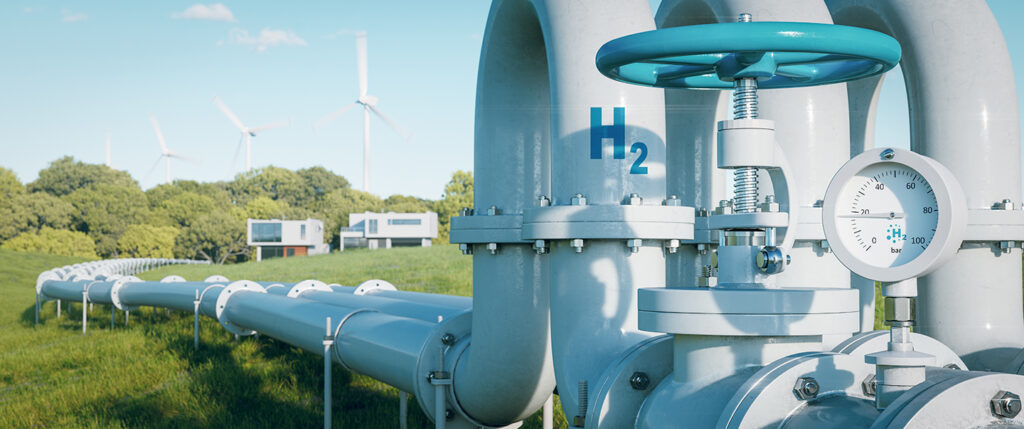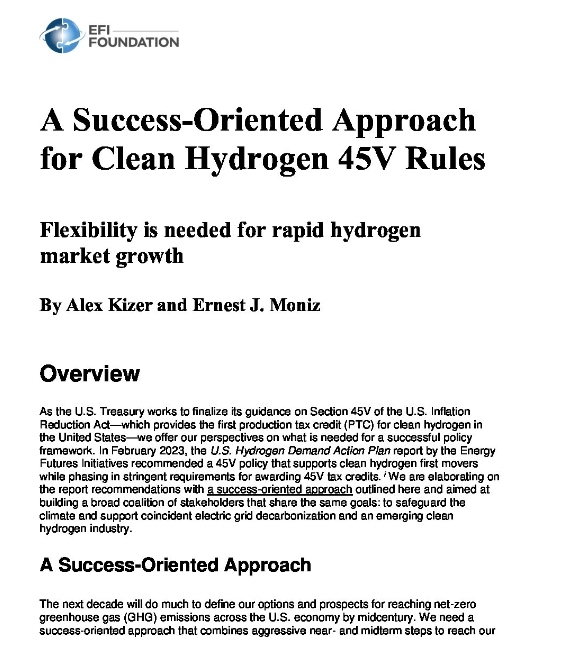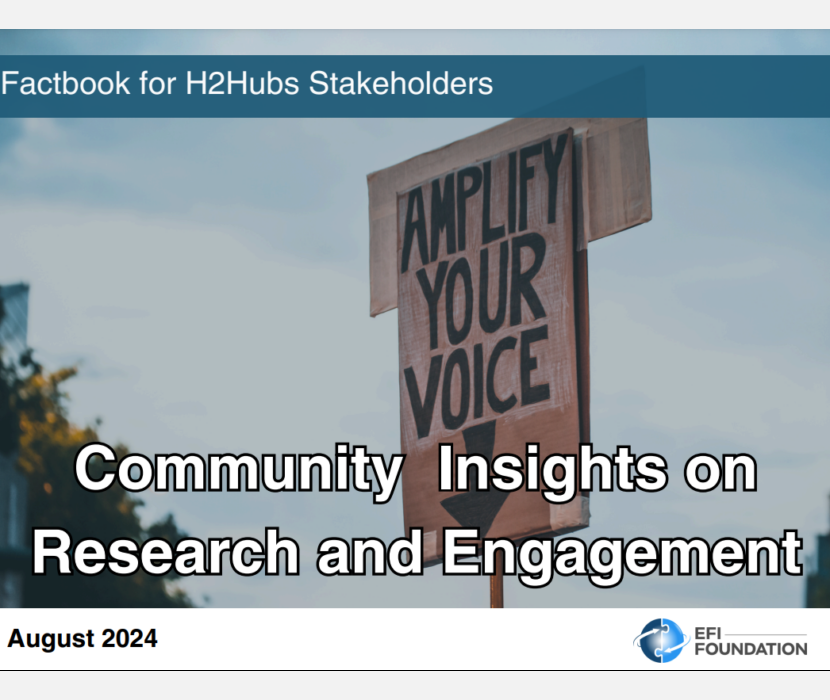
By Alex Kizer and Ernest J. Moniz
Overview
As the U.S. Treasury works to finalize its guidance on Section 45V of the U.S. Inflation Reduction Act—which provides the first production tax credit (PTC) for clean hydrogen in the United States—we offer our perspectives on what is needed for a successful policy framework. In February 2023, the U.S. Hydrogen Demand Action Plan report by the Energy Futures Initiatives recommended a 45V policy that supports clean hydrogen first movers while phasing in stringent requirements for awarding 45V tax credits. [i] We are elaborating on the report recommendations with a success-oriented approach outlined here and aimed at building a broad coalition of stakeholders that share the same goals: to safeguard the climate and support coincident electric grid decarbonization and an emerging clean hydrogen industry.
A Success-Oriented Approach
The next decade will do much to define our options and prospects for reaching net-zero greenhouse gas (GHG) emissions across the U.S. economy by midcentury. We need a success-oriented approach that combines aggressive near- and midterm steps to reach our longer-term deep decarbonization objectives, including a net-negative emissions economy in the second half of the 21st century. By 2030, among other actions, we must:
- Reduce carbon dioxide (CO2) emissions from the electric grid significantly, driven primarily by large-scale deployment (hundreds of gigawatts) of new wind and solar resources.
- Ramp up efforts to electrify the economy. These efforts are currently led by electric vehicles and should extend as much as possible to buildings and industry.
- Develop and deploy the low-carbon solutions for fuels services that will be needed to decarbonize the hard-to-electrify sectors of the U.S. economy (e.g., some heavy industrial processes and aviation). Clean hydrogen is a leading candidate for filling the need for fuels services, and appreciable gains in hydrogen market formation will be needed by 2030 (which is the intent of the 45V tax credits, alongside grid decarbonization).
Guided by this vision, we identify the following goals for the implementation of the 45V tax credits:
Goal #1. Clean hydrogen supply for long-term emissions reductions.
Clean hydrogen production is essential for significant long-term impacts on emissions reductions, especially for the most difficult-to-electrify sectors. For hydrogen to deliver, its production must create little to no carbon emissions, and the upcoming Treasury guidelines for the implementation of the 45V credits must adhere to this objective. Success in deploying large amounts of zero-carbon electricity supply will naturally support the growth of clean hydrogen production.
Goal #2. Policy flexibility that enables first movers.
Near-term policy flexibility is necessary to enable rapid growth of a new clean hydrogen industry while not undermining Goal #1. The PTC guidelines must enable, not deter, new near-term clean hydrogen investments. Hydrogen demand-side challenges must be overcome to support supply chain development and market scaling—critical for all hydrogen use cases. The European Union’s (EU) Hydrogen Delegated Act embeds near-term policy flexibility for new clean hydrogen projects by phasing-in certain rules over the next few years as the industry develops. Clearly, near-term flexibility in 45V policy guidelines should not permit major near-term, system-wide impacts on carbon emissions, but it is of overarching importance to reinforce the success strategy noted above: simultaneous development of a low-carbon grid and a rapidly growing hydrogen industry. Therefore, Treasury should design 45V guidelines to provide investors with a clear path forward for phasing in stringent lifecycle emissions requirements.
Goal #3. New clean supply, regionality, and time-matching that support decarbonization and hydrogen industry scaling.
The three pillars of new clean electricity supply, regionality, and time-matching are a workable framework to support both Goal #1 and Goal #2. The three pillars help to clarify the appropriate ways to measure the emissions intensity of the electric grid—a complex task for a highly dynamic system fed by a pool of generators (renewables, nuclear, and fossil fuels) with profiles that change hourly, daily, monthly, and seasonally. The three pillars set some system boundaries to protect against unintended operational, environmental, or societal impacts. However, interpretation matters. For example, avoidance of loss of zero-carbon sources (especially nuclear and hydro) must be enabled in tandem with expansion of new zero-carbon generation. And effective strategies for clean hydrogen production could include carbon emissions offsets as well as additional negative-carbon technology deployment outside the region of hydrogen production and use. Treasury should consider the three pillars as a workable framework with interpretations that support overall system decarbonization and clean hydrogen industry scaling.
These three goals can be supported by a success-oriented approach that advances long-term carbon emissions reductions, scales the clean hydrogen industry in the near term, and creates robust clean hydrogen supply and use. This approach allows for a degree of flexibility in several dimensions to support early investment without locking in long-term carbon emissions increases. Deep decarbonization of the electric grid and clean hydrogen development must proceed hand-in-hand.
Introduction
There is unprecedented policy momentum for clean hydrogen in the United States. In April 2021, President Biden pledged to reduce GHG emissions by 50 to 52 percent by 2030 from a 2005 baseline and achieve net-zero emissions by midcentury. To contribute to reaching these targets, the Infrastructure Investment and Jobs Act (IIJA) provides $1 billion (B) for clean electrolysis research and development (R&D) and $8B for regional clean hydrogen hubs, and the Inflation Reduction Act (IRA) offers in Section 45V the clean hydrogen PTC and incentives for new enabling technologies and systems.
The Department of Treasury, White House, and Department of Energy (DOE) are considering guidance on the implementation of 45V that will shape the trajectory of the clean hydrogen industry in the United States for the next decade and beyond. The IRA clearly states the goals of the 45V policy: to incentivize hydrogen production with very low lifecycle (“well-to-gate”) GHG emissions. A wide range of analyses, including by the EFI Foundation, shows that IRA incentives can significantly lower the cost of clean hydrogen production and make it cost-competitive with status quo, natural gas-derived hydrogen in many regions in the United States. While this paper focuses on hydrogen produced by electrolysis of water, we also encourage parallel development of a low-carbon hydrogen supply derived from natural gas with carbon capture, utilization, and storage. IRA tax incentives support such directions as well. Furthermore, EFI’s analysis shows the clean hydrogen industry should be supplied by a range of clean electricity generation resources (including wind, solar, nuclear, and hydro) across many U.S. regions.
However, there are significant issues about how to: 1) account accurately for the energy system-wide lifecycle emissions of deploying new production technologies for clean hydrogen; 2) design a clear and implementable policy framework that encourages investment; and 3) enable the development of a new clean hydrogen industry in the United States that supports—and does not derail—climate progress.
Designing a workable 45V framework that achieves its stated goals depends on support from a broad coalition of stakeholders.1 EFI is providing observations and recommendations to the clean hydrogen PTC conversation after discussions with researchers, environmental and clean energy NGOs, industry groups, investors, and environmental justice organizations.
Expanding Options for Additionality
New clean electricity supply (or “additionality”) for grid-connected projects ensures that electrolytically produced hydrogen is not only clean but also additive to the existing generation base. However, there should be expanded options for additionality, aimed at supporting the nascent industry while safeguarding against long-term emissions increases.These technology-neutral options may not be comprehensive, though they are conceived to be stackable for any project developer.
- New builds: This pathway could cover clean energy projects placed-in-service for a short and timebound number of years before the clean hydrogen project. This time-bound glidepath is important as clean energy projects take time to build, permit, and interconnect. For example, the EU’s Hydrogen Delegated Act offers a useful precedent, requiring that a clean energy project come into service no more than 36 months prior to the hydrogen project to count as a new build. In the United States, a comparable timeframe would be appropriate—as it aligns with existing tax law (see below)—factoring in the success factor of continuous electric grid emissions reductions that depends on significant improvements in transmissions interconnection times.
- Uprates and repowered facilities: Clean energy capacity that meets Treasury’s definition of repowered should be considered as meeting the additionality requirement for 45V eligibility. Existing tax law considers repowered plants as “new” for the first 36 months.
- Clean electricity not delivered to load: The need to increasingly unlock stranded clean energy resources across the country likely will increase over the next decade. To support this need, electrolytic hydrogen projects should be able to draw electricity from existing clean electricity generation projects that are experiencing challenges in serving load due to persistent congestion in electricity transmission evidenced by curtailment, very low or negative prices or other identified market challenges. Colorado lawmakers introduced one example solution for their state: a tariff for carbon-free energy that would otherwise be curtailed.[ii] “Persistent congestion” must be rigorously defined to ensure that the pool of existing clean energy projects is not unduly expanded in a manner that increases system emissions. While we recognize the administrability questions of defining these conditions, we firmly believe that an adequate workable solution can be identified for all regions. The American Clean Power Association, for example, has noted that members are working on a framework to verify that a clean energy project is experiencing persistent congestion or curtailment. Addressing this issue requires flexibility to be able to adapt to the implications of changing congestion or curtailment conditions over time as the electricity grid evolves.
- Avoided retirement or license-extending opportunities of existing clean generators. Existing clean electricity generation projects that can demonstrate that sales to support new clean hydrogen production will enable continued operation at capacity or avoided retirement should qualify as meeting the additionality requirement for 45V eligibility. The continued operation of existing carbon-free electricity generators is critical to reaching our decarbonization targets. A carbon-free generator such as an existing nuclear or hydroelectric plant, could qualify for meeting the additionality requirement if the sale of electricity for clean hydrogen production is a factor in the decision to pursue operating life extension during any 10-year term of the hydrogen credits. The hydrogen producer, working with the carbon-free electricity generator, must provide necessary justification to the Internal Revenue Service (IRS) to support claims of relicensing or avoidance of retirement. A framework may be needed that includes power demand forecasting to justify the economic opportunity provided by the hydrogen sales, which, in effect, creates an additional firm off-taker for the existing clean electricity generator.
For first mover projects that cannot meet the expanded definitions in the near-term (e.g., by 2030), additionality could be phased to promote market scaling, aligned with the EU’s Hydrogen Delegated Act rules. The operational profile, and thus emissions intensity, of each U.S. electric grid region varies considerably. EFI’s analysis shows that the negative emissions impacts of expanded additionality criteria increase as the scale of grid-connected electrolyzers expands. The amount of “headroom” for electrolyzers to scale before emissions increase can be relatively small (e.g., 10MW scale) or relatively large (e.g., 1 GW scale) depending on the NERC grid region of the country. Allowing more flexible requirements for additionality could be limited by establishing a near-term deadline for operations or setting a quantitative limit based on electrolyzer load by grid region. This could limit negative emissions consequences while facilitating first mover projects, unlocking the project cost declines needed to build up domestic supply chains for market scaling. Ultimately this policy should create certainty for these early-mover projects that will be vital to enabling project cost declines and build up the domestic supply chains needed to scale clean hydrogen in the United States.
Phasing-in Time Matching
A phase-in from annual to hourly emissions tracking would provide essential flexibility to the nascent hydrogen industry in the early years, while preventing long-term emissions increases on the grid. For grid-connected hydrogen projects, matching the zero-carbon electricity supply with hydrogen production on an hourly basis ensures the power is directly reducing the effective emissions of a hydrogen production project. The electricity grid’s carbon emissions intensity currently changes significantly from hour-to-hour. Even though this calls for eventual hourly matching, the phase-in period requires more flexibility. Also, the importance of the timing shrinks as the grid is aggressively decarbonized, which is a key part of our success strategy. Failure to decarbonize the grid would present much greater challenges than those arising from a phase-in period, which underpins our call for a success strategy in shaping 45V implementation.
- A transition from annual to hourly matching should be midterm, aligned with the phase-in adopted by the European Union. The EU Hydrogen Delegated Act adopts a phase-in of hourly matching for all projects by 2030 and does not allow any grandfathering of projects under the more flexible initial rules beyond that date. Research groups estimate that unbounded grandfathering of annually matched projects can drive hundreds of millions of tons of cumulative emissions increases over the credit’s lifetime, which could last to the 2040s (given that the 45V credit lasts for 10 years). A more flexible approach would allow grandfathering for a limited set of early movers (e.g., projects entering operation by a certain near-term date) over their lifetime to establish investor certainty in initial deployments, recognizing the critical need for near-term market liftoff. Hourly matching will be unnecessary in the longer-term as the industry scaling drives down production costs and the electricity grid becomes fully or nearly fully decarbonized. The time-matching issue is complicated by the highly variable average emissions intensity of each grid region. EFI’s analysis shows that the negative emissions impacts of grandfathering increase as the scale of grid-connected electrolyzers increase. In many grid regions, the inflection points of negative consequences increase as the total regional electrolyzer load gets closer to the gigawatt scale.
Sensible Deliverability
Deliverability of clean power to where a hydrogen project is located is important for system-wide operational challenges and to prevent emissions increases. Implementing deliverability should strike a balance between ease of administrability and avoiding undue geographic restrictions for clean hydrogen deployment. Acknowledging the grid’s complexity, this framework is intended to promote the physical deliverability of clean power generation contracted to supply a hydrogen project or producing credits used by the hydrogen producer in a book-and-claim system. It also aims to avoid scenarios where other higher-emitting resources closer to the point of power consumption need to be dispatched to serve that additional electrolyzer demand.
- A straightforward approach is needed for 45V implementation that provides both certainty for hydrogen producers and minimizes the risk of occurrence of major transmission constraints between a hydrogen project and clean energy project. There are several options for implementing this framework at different grid units of analysis. One potentially workable option is requiring that the two projects be located in the same Environmental Protection Agency (EPA) eGRID subregion. EPA eGRID subregions are bounded by the North American Electric Reliability Corporation (NERC) regions (which can be too large) and balancing authorities (which can be too narrow) and provide a reasonable and straightforward solution; EPA subregions are also commonly used in the context of Scope 2 emissions reporting under the GHG Protocol. Another option could be to rely on “congestion regions,” as identified by the DOE’s National Transmission Needs Study. Congestion regions delineate regions separated by significant transmission constraints and the study is produced and updated on a recurring basis by a federal agency with appropriate expertise.
- However, it is also important that the IRS does not unduly geographically restrict clean hydrogen deployment to only those areas of increasing clean electricity deployment. As we outlined in our success-oriented vision, we will need to develop new clean electricity generation in all regions at unprecedented scale in this decade to stay the decarbonization course. For example, we should not disqualify certain types of emissions offsets or verifiable CO2 removal technologies that will be critical to enabling the economywide clean energy transition on the basis of regionality. While the principal focus should be on linking new clean electricity supplies to new clean hydrogen production within defined geographical areas, such as proposed hydrogen hubs or established electricity grids, the IRS could address exceptions through special rules for projects to procure clean electricity across eGRID regions. Special rules could include, for example, a rule where a hydrogen producer would need to demonstrate that the average difference in locational marginal prices (LMPs) between relevant eGRID subregions or congestion regions in the year prior to the in-service date of the hydrogen project was less than some appropriately low threshold. This would allow a hydrogen project to meet the deliverability requirement and avoid uncertainties associated with LMP variability.
Conclusion
We recognize the need for a success-oriented approach to create the broad coalitions needed to scale an emerging clean hydrogen industry in the United States while safeguarding the climate and supporting—not hindering—achievement of our 2030 and 2050 climate goals. In other words, we need a policy framework for today and one that unlocks the clean energy transition that we need over the next decade as a viable ramp toward very deep decarbonization by midcentury. The reality is that grid decarbonization has made considerable strides as the leading contributor to GHG emissions reduction and, while we cannot afford to take our foot off the pedal, clean hydrogen market formation is barely getting off the ground. Implementation of 45V needs to accelerate that market formation while benefiting from the presumed continuation of aggressive grid decarbonization.
While the approach offered here does not cover every scenario and elucidate each detail, these success-oriented policy goals and design elements can hopefully move the discussion forward and ramp-up on a timescale aligned with grid decarbonization.
[i] https://efifoundation.org/reports/the-u-s-hydrogen-demand-action-plan-2/
[ii] 2023a_1281_signed.pdf (colorado.gov)
Downloadable PDF
(Share this post with others.)





